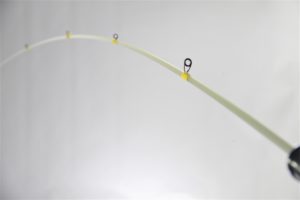Materials for mountain stream trout rods
It seems that glass rods and ultra-low elasticity composite blanks that combine glass and carbon are popular for mountain stream lures these days.
Hitotoki Works will finally be selling the "RUNTMAN" short rod, made of 950mm low-elasticity carbon, in July 2020.
I was honestly surprised at the number of reservations, which exceeded my expectations, as there must be a lot of people who are attracted to low-elasticity carbon short rods.

View RUNTMAN product page
First, let's summarize the differences, advantages and disadvantages between glass and carbon materials based on Hitotoki Works' own interpretation.
Before carbon fiber was invented, it was the mainstream material for fishing rods.
Glass rods are made from glass and resin materials, and there are two types of glass rods: solid, which is cut out of a rod-shaped glass material on a lathe, and tubular, which is formed from a core wire.
In addition to fishing, glass is also used for flags, antennas, various supports, and in agriculture, vinyl frames to protect vegetables.
Since it is a solid material, the material itself is heavy and has the characteristic of having a much stronger limit strength when bent than hollow materials.

For this reason, they are primarily used for heavy-duty fishing that does not require casting, such as bait rods on boats, trolling for swordfish, and single-line fishing for bonito.
Another feature is that it does not have the stiffness (tension) of hollow materials.
So, when bait fishing, not only does it make it easier for fish to take the bait without feeling uncomfortable, it also has the added benefit of absorbing the rocking of the boat.
Because the material is heavy, the rod will bend automatically when casting, even with a light lure, making it easy to cast steadily, which is an advantage when using mountain stream lures where pinpoint casting is required.

It's heavier than carbon.
However, since the lures used only weigh about 5g, there is no need to use thick glass solid materials, and there is no need to cast far, so the rod can be short, minimizing stress caused by weight.
Another benefit is that it's fun to throw.
I think the biggest advantage is that it's fun because even small fish can bend!
Furthermore, when fighting with large fish, the elasticity of the rod makes it less likely for the fish to thrash around, the hook to stretch, and the line to break.
In the case of a hollow material, if the outer diameter is the same as that of a solid material, the hollow material will have a stronger resilience.
This means less material is required to withstand the required lure load, making it lighter.
Compared to carbon, it is heavier and has weaker rebound force.
I feel like it's somewhere between glass solid and carbon.

I think it's perfect for fishing where you want to take advantage of the memory foam of glass while also looking for hardness and lightness.
in particular,
・I want to handle some heavy lures!
・You need a certain length, not a short rod!
・I want a rod with low elasticity, but I want a little more resilience than a glass solid! I want it to be lighter!
I think it will satisfy such dissatisfaction.
Since different people have different priorities, it's hard to say which material is best.
I hope this will help you choose a rod after understanding the advantages and disadvantages!!
Glass rods are short but flexible, which allows for stable casting, but they have the following disadvantages:
1. The butt is bent, so hooking performance is poor.
2. Poor sensitivity
3. Weak repulsion results in poor flight distance
4. The slow tip convergence speed and the butt bends too much, making it difficult to perform high-pitched lure action.
5. The weight of the chair puts strain on your wrists.
The biggest advantage of glass solid is its casting performance, but the low-elasticity carbon with a slim and thick design eliminates its disadvantages.
It is probably low-elasticity carbon that provides a flexible tip like a glass solid and a firm, taut butt for stress-free attacking action.

View RUNTMAN product page





